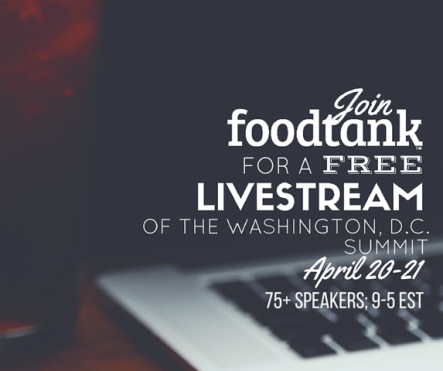- “I’m disappointed that the rules don’t go as far as what was proposed early this year,” said Danielle Nierenberg, president of Food Tank, a nutrition advocacy group. “USDA has missed an opportunity to increase the availability of and access to healthier foods for low-income Americans.”
The earlier proposals also recommended leaving food with multiple ingredients like frozen pizza or canned soup off the staple list. The outcome is a win for the makers of such products, like General Mills Inc. and Campbell Soup Co., which feared they would lose shelf space as retailers added new items to meet the requirements.
But retailers still criticized the new guidelines as too restrictive. Stores must now stock seven varieties of staples in each food category: meat, bread, dairy, and fruits and vegetables….
…More changes to the food-stamp program may lie ahead. The new rules were published a day after the House Committee on Agriculture released a report* calling for major changes to the program, which Republicans on the committee say discourages recipients from finding better-paid work.
Source: Regulators Tweak SNAP Rules for Grocers – WSJ
*Some of the findings from the 2016 Committee on Agriculture Report “Past, Present, and Future of SNAP” are below.
- • Program participation nearly doubled (up 81 percent from FY 2007 to FY 2013) as a result of the recent recession. In an average month in FY 2007, 26.3 million people (or about 9 percent of the U.S. population) were enrolled in SNAP. That increased to 47.6 million people (or about 15 percent of the U.S. population) in FY 2013, owing to the fact that the economy was slow to recover and many families remained reliant on SNAP. Even now, with a 4.6 percent unemployment rate (compared to a 9.6 percent unemployment rate for 2010), there were still 43.4 million SNAP participants as of July 2016.
- • SNAP is now a catchall for individuals and families who receive no or lower benefits from other welfare programs, largely because the eligibility criteria in SNAP are relatively more relaxed. As a result, the net effect has been to increase SNAP enrollment. For example, in the welfare reforms of 1996, the cash welfare program Aid to Families with Dependent Children (AFDC) was converted into a block grant known as TANF, which has rather rigorous work and activity requirements and includes a time limit. Another program available to those who are laid off from work is Unemployment Insurance (UI). These benefits require individuals to have a work history and to be fired through no fault of their own to be eligible for assistance. UI benefits are also time-limited, typically lasting six months. A third program, Federal disability benefits, requires individuals to prove they are unable to work. For many families who have not collected SNAP in the past, SNAP is now a default option for filling in the gaps.
- • USDA data shows that spending on SNAP remains three times what it was prior to the recession ($23.09 billion pre-recession average compared to $73.99 billion post-recession in FY 2015). However, SNAP spending is now projected to be significantly lower than it was estimated at passage of the 2014 Farm Bill.
- • For FY 2017, the maximum monthly benefit in the 48 contiguous states and DC is $194 for a one-person household, $357 for a two-person household, and $649 for a four-person household.17 In determining a household’s benefit, the net monthly income of the household is multiplied by 30 percent (because SNAP households are expected to spend 30 percent of their income on food), and the result is subtracted from the maximum benefit to determine the household’s benefit.
- • Seniors have the lowest rates of SNAP participation among eligible households of any demographic. While the low participation rate has a variety of causes, a prominent explanation is the stigma associated with SNAP and welfare in general. Many factors contribute to a lack of access to food among seniors, including a lack of a substantial income, the gap between Medicaid and the cost of living, limited income with specialized diets, and mental and physical illnesses. The issues facing these populations must be viewed holistically, with SNAP as one piece of a larger solution to solving hunger for seniors.
According to research by the AARP Foundation—a charitable affiliate of AARP—over 17 percent of adults over the age of 40 are food-insecure. Among age cohorts over age 50, food insecurity was worse for the 50-59 age group, with over 10 percent experiencing either low or very low food security. Among the 60-69 age cohort, over 9 percent experienced similar levels of food insecurity, and over 6 percent among the 70+ population.
• The operation of the program is at the discretion of each state. For instance, in California, SNAP is a county-run program. In Texas, SNAP is administered by the state… Dr. Angela Rachidi of the American Enterprise Institute cited a specific example in New York City where SNAP, WIC, school food programs, and child and adult care programs are all administered by different agencies and the result is that each agency must determine eligibility and administer benefits separately.
K. Michael Conaway, Chairman of the House Committee on Agriculture. Hearing of the House of Representatives, Committee on Agriculture. Past, Present, and Future of SNAP. February 25, 2015. Washington, D.C. Find report here
From CNN this week:
The number of people seeking emergency food assistance increased by an average of 2% in 2016, the United States Conference of Mayors said in its annual report Wednesday.
The majority, or 63%, of those seeking assistance were families, down from 67% a year ago, the survey found. However, the proportion of people who were employed and in need of food assistance rose sharply — increasing to 51% from 42%.

